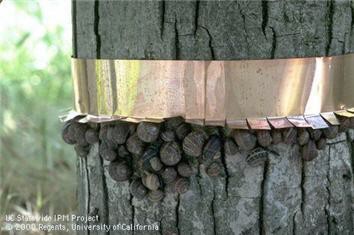Abstract
If you have a garden, you probably know about snails (or their shell-less relatives, slugs). You may even be looking for a good way to keep them from getting into your garden and eating up the results of all your hard work. In this science project, you will take a scientific look at one method of discouraging this garden pest.Summary
Sources
This project is based on:- Mueller, S.C., 2004. Effectiveness of Copper Banding in Preventing Brown Garden Snails (Helix aspersa) from Reaching Food Sources, California State Science Fair Abstract. Retrieved August 4, 2006.
- Liu, K., date unknown. Eye to Eye with Garden Snails, Access Excellence @ The National Health Museum. Retrieved August 4, 2006.

Objective
This project has two goals:
- To determine if snails (or slugs) are attracted to or repelled by certain substances;
- If repellent substances can be identified, can they protect citrus trees (or garden plots) from snails (or slugs) and the damage they cause?
Introduction
The common garden snail is a nuisance to home gardeners, and can be the cause of major damage in citrus groves (UC IPM, 2014). Snail and slug poisons are available, but perhaps there are methods for protecting gardens and crops from snails and slugs that are more environmentally friendly? Are there substances that can work as effective snail or slug repellents to protect citrus trees from snails? Would these substances work for garden plots as well?
 Image Credit: Regents, University of California (photo by Jack Kelly Clark) / Copyrighted
Image Credit: Regents, University of California (photo by Jack Kelly Clark) / Copyrighted
The University of California's Integrated Pest Management webpage (UC IPM, 2014) suggests using copper banding to deter snails. As shown in Figure 1, above, it seems to be an effective method. Can you think of other substances that might work as a "keep out" sign for snails or slugs? Do other metals work? Since snails and slugs glide along on a secretion of mucus, would rough surfaces work to deter their progress? Might other parts of snail anatomy affect what substances you test? In this zoology science project, you will investigate different substances to see if they work as repellents or attractants against snails or slugs, and, if you identify repellent substances, you will determine whether they could be used to protect citrus trees (or garden plots) from damage caused by snails or slugs.
Terms and Concepts
- Repellents
- Snail anatomy: tentacles, eyes, foot
- Attractants
- How do snails move?
- What do snails eat?
- What is the preferred habitat of the garden snail?
Bibliography
This page has detailed pictures of the external and internal anatomy of the garden snail:- Herreid, C. (November 15, 1999). Snail Helix aspersa. Evolutionary Biology, Biology 200, Laboratory Tutorial, Department of Biological Sciences, State University of New York, Buffalo. Retrieved January 9, 2014.
- University of California, Integrated Pest Management Program (UC IPM). (January 8, 2014). UC Management Guidelines, Brown Garden Snail on Citrus. Agriculture and Natural Resources. Retrieved January 9, 2014.
- Dekle, G.W. and T.R. Fasulo. (n.d.). Brown Garden Snail, Cornu aspersum (Müller, 1774) Gastropoda: Helicidae. Department of Agriculture, University of Florida. Retrieved January 9, 2014.
Materials and Equipment
- Garden snails or slugs. Note: You should only do this science project if you live in an area where you routinely see land snails or slugs. Land snails and slugs are most likely to be out and active when it is damp out, such as in the early morning or after it has rained, or you may find them hiding under plant leaves.
- Optional: Disposable gloves. If you choose to use slugs, you may also want to use disposable gloves when handling the slugs. Disposable gloves can be purchased at a local drug store or pharmacy, or through an online supplier like Carolina Biological Supply Company. If you are allergic to latex, use vinyl or polyethylene gloves.
- Large plastic box
- Plant pots
- Potential snail attractants: lettuce, apple slices, orange slices, etc.
- Potential snail repellents. Check your local hardware store for the following: copper foil or sheet metal, aluminum foil or sheet metal, sandpaper, etc. Note: Do not use sugar, salt, laundry detergent, slug bait, or other substances known to kill snails.
- Lab notebook
Disclaimer: Science Buddies participates in affiliate programs with Home Science Tools, Amazon.com, Carolina Biological, and Jameco Electronics. Proceeds from the affiliate programs help support Science Buddies, a 501(c)(3) public charity, and keep our resources free for everyone. Our top priority is student learning. If you have any comments (positive or negative) related to purchases you've made for science projects from recommendations on our site, please let us know. Write to us at scibuddy@sciencebuddies.org.
Experimental Procedure
For health and safety reasons, science fairs regulate what kinds of biological materials can be used in science fair projects. You should check with your science fair's Scientific Review Committee before starting this experiment to make sure your science fair project complies with all local rules. Many science fairs follow Regeneron International Science and Engineering Fair (ISEF) regulations. For more information, visit these Science Buddies pages: Project Involving Potentially Hazardous Biological Agents and Scientific Review Committee. You can also visit the webpage ISEF Rules & Guidelines directly.
- Note: If you are using slugs, you may want to wear disposable gloves while handling them.
- There are many possible ways to test substances to see whether they repel snails or slugs. With any of these methods, you will need to perform repeated trials to make sure that your results are consistent. Choose one of the following methods (or try several of them to see which works best for you):
- Place the substance directly in the path of a moving snail or slug and observe whether or not the snail or slug changes direction when it encounters the substance;
- Cover the bottom of a plastic box with different substances, and release one or more snails or slugs into the box; use time-lapse photography to determine how much time snails or slugs spend over each substance;
- Place the substance in a ring around one or more snail(s) or slug(s) and observe the behavior of the snail(s) or slug(s).
- To test attractant substances, try the following procedure:
- Put several inverted clay pots in a plastic box.
- Place samples of the substances to be tested on top of the pots.
- Leave at least one pot empty.
- Release snails or slugs into the box and observe their behavior.
- You may need to moisten the test area with a spray bottle of water to encourage the snails or slugs to explore.
- Count the proportion of snails or slugs on each pot.
- Conduct multiple trials and average the results.
- To test the relative effectiveness of different snail or slug repellents, try the following procedure for each substance to be tested:
- Put a single inverted clay pot in a plastic box.
- Half-way up the pot, wrap (or coat) the pot with the repellent substance to be tested.
- On top the pot, place a sample of the most attractive substance identified in the previous step.
- Release snails or slugs into the box and observe their behavior.
- You may need to moisten the test area with a spray bottle of water to encourage the snails or slugs to explore.
- How many snails or slugs attempt to approach the bait? How many succeed in crossing the repellent substance being tested?
- Conduct multiple trials and average the results.
- You can create graphs of your results.
- For example, for your data with the attractants, you can put the attractant substance on the x-axis (the horizontal axis) and the proportion of snails on each pot on the y-axis (the vertical axis).
- When you are done with your experiments, analyze your results.
- Which of the substances you tested worked well as repellents for the snails or slugs? Which of the substances worked well as attractants?
- If you identified repellents, did they effectively protect the attractive substance from being eaten by the snails or slugs? Do you think the repellents could be effectively used to protect citrus trees or garden plots from snails or slugs?
Ask an Expert
Global Connections
The United Nations Sustainable Development Goals (UNSDGs) are a blueprint to achieve a better and more sustainable future for all.
Variations
- Test the effectiveness of other metals (e.g., aluminum foil) for protecting citrus trees from snails or slugs. Can you measure a voltage between the snail or slug's foot and copper sheet metal? Between the snail or slug and other metals?
- Does copper banding remain effective even after it has been exposed to the weather and become oxidized? For speeding up the process of weathering the copper, soak it with vinegar overnight.
- How fast do snails or slugs move? How is a snail or slug's speed affected by variables such as surface texture, moisture, temperature? (Remember to design your experiment so that you test a single variable at a time.) For the most reliable results, it is best to make measurements using many individual snails or slugs, using repeated trials for each individual.
- For many garden plants, wrapping the stem in copper is impractical. Is it possible to protect an entire garden? Does a border made of copper sheet metal keep snails or slugs out of a garden plot? Compare side-by-side beds using different border materials, and take a regular "snail census" or "slug census" to find out.
Careers
If you like this project, you might enjoy exploring these related careers:









